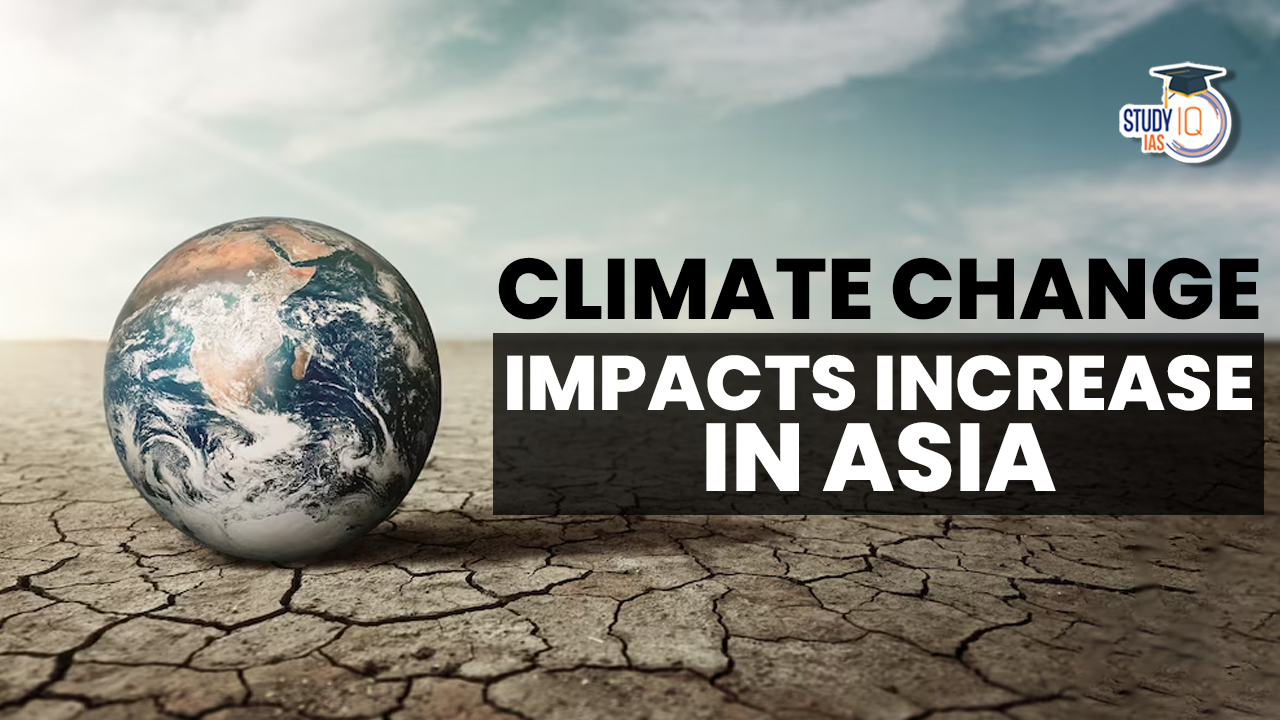Context: According to a new report by the World Meteorological Organization (WMO), Asia is the world’s most disaster-prone region and it experienced 81 weather, climate and water-related disasters in 2022.
Key Highlights of the Report
| Warming in the Region |
- The mean temperature over Asia for 2022 was the second or third warmest on record and was about 0.72 °C above the 1991–2020 average.
- The mean temperature over Asia in 2022 was about 1.68 °C above the 1961–1990 average.
|
| Disasters |
- There were 81 weather, climate and water-related disasters in Asia in 2022, of which over 83% were flood and storm events.
- More than 5 000 people lost their lives, more than 50 million people were directly affected and there were more than US$ 36 billion in economic damages, according to the report.
- In addition, a large part of arid Asia experienced severe dust storms. Several severe dust storm events in western Asia affected civil lives in the region.
- Droughts:
- Drought affected many parts of the region, reducing water availability.
- The economic losses in 2022 as a result of the drought in China, for example, were estimated to exceed US$ 7.6 billion.
- Floods:
- Severe flooding hit Pakistan, causing significant loss of life and economic damage.
- Pakistan received 60% of its normal total monsoon rainfall within just three weeks of the start of the monsoon season in 2022.
- According to the National Disaster Management Authority (NDMA), more than 33 million people, almost 14% of Pakistan’s 2022 population, were affected.
|
| Glacial Melting |
- Glaciers in the High Mountain Asia region have lost significant mass over the past 40 years, and the loss is accelerating.
- In 2022, exceptionally warm and dry conditions exacerbated the mass loss for most glaciers.
- Urumqi Glacier No. 1 in the eastern Tien Shan recorded the second highest negative mass balance of -1.25 metre water equivalent since measurements began in 1959.
|
| Ocean Warming |
- The region shows an overall surface ocean warming trend since the time series began in 1982.
- In the north-western Arabian Sea, the Philippine Sea and the seas east of Japan, the warming rates exceed 0.5 °C per decade, which is about three times faster than the global average surface ocean warming rate.
|
| Economic Losses |
- Economic losses in 2022 due to disasters relating to floods exceeded the average for the 2002–2021 period.
- The most significant losses of this type were in Pakistan (over US$ 15 billion), followed by China (over US$ 5 billion), and India (over US$ 4.2 billion).
- Economic losses in 2022 associated with droughts were the next largest category, causing US$ 7.6 billion in damages (mainly in China); this exceeds 2002–2021 average (US$ 2.6 billion) by nearly 200%.
|
About the World Meteorological Organization (WMO)
- The World Meteorological Organization (WMO) is an intergovernmental organization with a membership of 193 Member States and Territories.
- India is a member of WMO.
- It originated from the International Meteorological Organization (IMO), the roots of which were planted at the 1873 Vienna International Meteorological Congress.
- Established by the ratification of the WMO Convention on 23 March 1950, WMO became the specialized agency of the United Nations for meteorology (weather and climate), operational hydrology and related geophysical sciences a year later.
- The Secretariat, headquartered in Geneva, is headed by the Secretary-General. Its supreme body is the World Meteorological Congress.
Sharing is caring!


 Justice BR Gavai will take oath as 52nd ...
Justice BR Gavai will take oath as 52nd ...
 Harnessing Spiritual Aastha for River Re...
Harnessing Spiritual Aastha for River Re...
 Daily Quiz 18 April 2025
Daily Quiz 18 April 2025





















